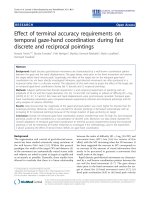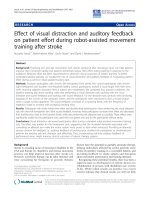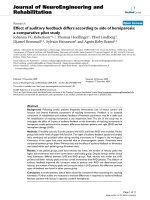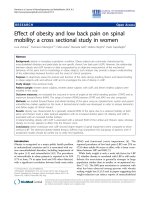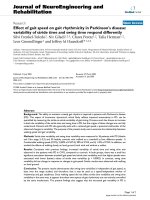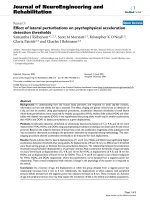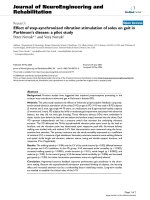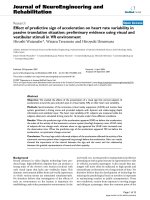Báo cáo hóa học: " Effect of influenza and pneumococcal vaccines in elderly persons in years of low influenza activity" potx
Bạn đang xem bản rút gọn của tài liệu. Xem và tải ngay bản đầy đủ của tài liệu tại đây (217.27 KB, 9 trang )
BioMed Central
Page 1 of 9
(page number not for citation purposes)
Virology Journal
Open Access
Research
Effect of influenza and pneumococcal vaccines in elderly persons in
years of low influenza activity
Brith Christenson
1
, Karlis Pauksen
2
and Staffan PE Sylvan*
1
Address:
1
Department of Communicable Disease Control and prevention, Uppsala County Counci, Dag Hammarskjolds vag 17, SE-751-85
Uppsala, Sweden and
2
Department of Medical sciences, Infectious Diseases, Uppsala University Hospital Uppsala, Sweden
Email: Brith Christenson - ; Karlis Pauksen - ; Staffan PE Sylvan* -
* Corresponding author
Abstract
Background: The present prospective study was conducted from 2003–2005, among all
individuals 65 years and older in Uppsala County, a region with 300 000 inhabitants situated close
to the Stockholm urban area.
The objective of this study was to assess the preventive effect of influenza and pneumococcal
vaccination in reducing hospitalisation and length of hospital stay (LOHS) even during periods of
low influenza activity. The specificity of the apparent vaccine associations were evaluated in relation
to the influenza seasons.
Results: In 2003, the total study population was 41,059, of which 12,907 (31%) received influenza
vaccine of these, 4,447 (11%) were administered the pneumococcal vaccine. In 2004, 14,799 (34%)
individuals received the influenza vaccine and 8,843 (21%) the pneumococcal vaccine and in 2005
16,926 (39%) individuals were given the influenza vaccine and 12,340 (28%) the pneumococcal
vaccine.
Our findings indicated that 35% of the vaccinated cohort belonged to a medical risk category
(mainly those persons that received the pneumococcal vaccine). Data on hospitalisation and
mortality during the 3-year period were obtained from the administrative database of the Uppsala
county council.
During the influenza seasons, reduction of hospital admissions and significantly shorter in-hospital
stay for influenza was observed in the vaccinated cohort (below 80 years of age). For individuals
who also had received the pneumococcal vaccine, a significant reduction of hospital admissions and
of in-hospital stay was observed for invasive pneumococcal disease and for pneumococcal
pneumonia. Effectiveness was observed for cardiac failure even in persons that also had received
the pneumococcal vaccine, despite that the pneumococcal vaccinated mainly belonged to a medical
risk category. Reduction of death from all causes was observed during the influenza season of 2004,
in the 75–84-year old age group and in all age-groups during the influenza season 2005.
Conclusion: The present study confirmed the additive effect of the two vaccines in the elderly,
which was associated with a reduced risk in hospitalisation and a reduction in mean LOHS in
seasons with low influenza activity.
Published: 28 April 2008
Virology Journal 2008, 5:52 doi:10.1186/1743-422X-5-52
Received: 14 February 2008
Accepted: 28 April 2008
This article is available from: />© 2008 Christenson et al; licensee BioMed Central Ltd.
This is an Open Access article distributed under the terms of the Creative Commons Attribution License ( />),
which permits unrestricted use, distribution, and reproduction in any medium, provided the original work is properly cited.
Virology Journal 2008, 5:52 />Page 2 of 9
(page number not for citation purposes)
Background
The administration of influenza and pneumococcal vac-
cines has been limited in many European countries. Only
4–8% of all persons in Sweden, received influenza vaccine
up to 1995. After 1997, however, the influenza vaccine
distribution increased considerably in Sweden as in many
other countries [1,2]. An annual influenza vaccination
among persons aged 65 years and older has been recom-
mended since 1997 and, according to the Swedish
National Board of Health and Welfare, pneumococcal
vaccination should also be considered for this age group.
The administration of both vaccines is also recommended
in persons with lung and heart problems.
The vaccination rate increased in the Stockholm area from
40% in 1998 to 48% in 1999 [3]. Earlier, costs of influ-
enza and pneumococcal vaccines have not been reim-
bursed in Sweden. After 2000, however, several counties
in Sweden, including Stockholm County, introduced
reimbursement for vaccination, which appears to be asso-
ciated with greater vaccine use. After the introduction of
the reimbursement policy, the vaccination rate has
increased to about 60% in the Stockholm County. On the
other hand, influenza vaccination is not reimbursed in
Uppsala County; despite this policy, the vaccination rate
in Uppsala County increased from 31% in 2003 to 39% in
2005.
The benefit of annual influenza vaccination has been doc-
umented in several case-control and retrospective cohort
studies [4-10]. Influenza vaccination has been reported to
reduce the need for hospitalisation in chronic respiratory
conditions and heart failure [11]. It has also been found
to reduce hospitalisation in cardiac disease and stroke in
elderly patients [12]. The effectiveness of influenza vacci-
nation and mortality in elderly persons, however, has
more recently been questioned, where it has been
explained by an unrecognised selection bias in cohort
studies [13,14].
Retrospective studies have shown that pneumococcal vac-
cine is efficacious against pneumonia and reduces hospi-
talisation and death that is due to pneumonia in elderly
people with chronic lung disease [15]. An additive effect
of influenza and pneumococcal vaccination in elderly per-
sons with chronic lung disease or cardiac failure has also
been demonstrated [16]. The additive effect of both vac-
cines has been supported by prospective intervention
studies preformed in1999 and 2000 in Stockholm County
[3,17,18].
This paper concerned the efficacy and benefit of influenza
vaccination in an elderly population during periods with
low influenza activity. A further concern was to study the
preventive effect of the pneumococcal vaccine. In the
present study we found that vaccination of elderly persons
was effective in preventing hospitalisation and in mean
length of hospital stay and also in reduction of mortality
that were caused by influenza and pneumonia.
Results
The influenza activity was low in Uppsala region as in the
rest of Sweden during the three influenza seasons
(i.e.2003–2005) (Figure 1). The lowest influenza activity
was observed in 2003. The influenza season peaked dur-
ing the middle of February with an incidence of 0.64%
among patients who sought the general practitioner that
participated in the sentinel influenza campaign. In 2004,
the influenza season was short; peaking at 3.1% during
the last week of December 2003 and the first week of Jan-
uary 2004. In 2005, the influenza activity occurred
around Christmas and peaked in the beginning of March
with an incidence of 1.3%.
Table 1 shows the proportion of the study population and
the distribution of the vaccinated individuals as a func-
tion of age. No difference was found in the proportion of
men and women among vaccinated and unvaccinated
individuals (data not shown).
The influenza vaccination rate increased during the 3-year
study period and was highest in the age group 80 years
and older.
The incidence of hospital admissions and of in-hospital
stay for influenza varied during the three influenza sea-
sons (December 1 to May 31 for the period 2003–2005).
In 2003, no influenza case of an individual below 80 years
old in the vaccinated cohort was admitted to hospital. No
significant reduction of hospital admissions was
observed. However, the in-hospital stay calculated as
mean LOHS (days) was significantly shorter for the vacci-
nated cohorts in 2003 and 2004 (Table 2).
Concerning invasive pneumococcal disease, the reduction
of hospital admissions was 68% (< 005) and for in-hospi-
tal stay 40% (<0.001) among persons who had received
both the pneumococcal and influenza vaccine as com-
pared with the non-vaccinated cohort and those who had
received only the influenza vaccine (data not shown) dur-
ing the period 2003–2005 (Table 3). For pneumococcal
pneumonia, the reduction of hospital admissions was
13% (< 0.8) and the reduction of in-hospital stay was
38% (< 0.001)
For pneumonia overall (Table 4) a reduction of hospital
admissions (38%–55%) and of in hospital treatment
(13%–49%) was found for individuals who had received
the influenza vaccine only during the three influenza sea-
Virology Journal 2008, 5:52 />Page 3 of 9
(page number not for citation purposes)
Proportion (%) of influenza-like illness out of a total number of patient visits in the sentinel systemFigure 1
Proportion (%) of influenza-like illness out of a total number of patient visits in the sentinel system.
0.00
0.10
0.20
0.30
0.40
0.50
0.60
0.70
43 44 45 46 47 48 49 50 51 52 1 2 3 4 5 6 7 8 9 10 11 12 13 14 15 16 17 18 19 20
Week
%
2002 - 2003
0.00
0.20
0.40
0.60
0.80
1.00
1.20
1.40
43 44 45 46 47 48 49 50 51 52 53 1 2 3 4 5 6 7 8 9 10 11 12 13 14 15 16 17 18 19 20
Week
%
2004 - 2005
0.00
0.50
1.00
1.50
2.00
2.50
3.00
3.50
434445464748495051521234567891011121314151617181920
Week
%
2003 - 2004
Table 1: Proportion of vaccinated individuals in different age groups, 2003–2005 in Uppsala County.
Individuals no Influenza vaccinated % Influenza- and pneumococcal vaccinated %
Age groups ≥ 65 65 – 79 ≥ 80 ≥ 65 65 – 79 ≥ 80 ≥ 65 65 – 79 ≥ 80
2003 41 059 28 177 12 861 31 28 40 11 10 14
2004 43 131 29 743 13 388 34 30 42 21 19 25
2005 43 781 30 270 13 510 39 36 45 28 27 31
Virology Journal 2008, 5:52 />Page 4 of 9
(page number not for citation purposes)
sons. No reduction was found in individuals who had
received both vaccines (data not shown).
To estimate the possible protective efficacy for cardiac fail-
ure individuals who had received either influenza vaccine
or both vaccines were compared with the non-vaccinated
cohort during the influenza seasons versus the non-influ-
enza seasons (Table 5). This comparison showed that the
persons who had received the influenza vaccine only and
those who had received both vaccines had a significantly
shorter in-hospital stay during the influenza seasons
(except for 2003) when there was low influenza activity
and no influenza case was admitted to hospital in the age
group 65–79 years.
When looking at death from all causes in relation to age
and vaccination status during the influenza seasons versus
the non-influenza seasons, 2003–2005, a reduction in
overall mortality was noted, during the influenza season
of 2004, for the age-group 75–84 years, and in all age
groups during the 2005 influenza season (Table 6).
Discussion
Consistent with other findings, the present prospective
study showed that influenza and pneumococcal vaccina-
tions are beneficial for elderly persons, even during peri-
ods of low influenza activity [9,10,13,16,19]. Three
prospective influenza and pneumococcal vaccination
intervention studies of an elderly population in Stock-
holm County in 1999 and 2000, with moderate or high
influenza activity found significantly lower hospital
admissions for influenza, pneumonia and invasive pneu-
mococcal disease in the vaccinated cohort as compared
with the non-vaccinated cohort [3,17,18]. Moreover, an
additive effect of the two vaccines was demonstrated. It is
well established that respiratory viruses predispose to bac-
terial complications. On average, 50% of patients hospi-
talised with influenza have bacterial pneumonia though
Table 2: Incidence and reduction of hospital admissions and in-hospital treatment (days) for influenza with or without respiratory
disease per 100 000 in vaccinated and unvaccinated cohorts during the influenza seasons (1 December – 31 May), 2003 – 2005.
Hospital admission In-hospital treatment
Incidence Reduction Incidence Reduction
Age-group Vaccinated Unvaccinated (95% CI) p Vaccinated Unvaccinated (95% CI) p
2003
65 – 79 0 19 0 98
≥ 80 39 103 62% (0,08–1,84) < 0.2 254 826 69% (0,17–0,57) < 0.001
2004
65 – 79 55 63 14% (0,46–1,59) < 0.8 175 379 54% (0,27–0,80) < 0.01
≥ 80 301 297 - 1% (0,53–1,90) < 0.96 1683 3073 46% (0,43–0,69) < 0.001
2005
65 – 79 83 103 20% (0,36–1,76) < 0.6 471 540 13% (0,62–1,40) < 0.4
≥ 80 441 351 - 21% (0,73–2,2) < 0.5 2684 2297 - 15% (0,94–1,45) < 0.2
Table 3: Incidence and reduction of hospital admissions and in-hospital treatment (days) for invasive pneumococcal disease and
pneumococcal pneumonia in influenza pneumococcal vaccinated and unvaccinated cohorts, 2003 – 2005.
Hospital admission In-hospital treatment
Incidence Reduction Incidence Reduction
(95% CI) p (95% CI) p
Invasive pneumococcal disease
Vaccinated 12 234
68% (0,1–1,06) < 0.05 40% (0,46–0,78) < 0.001
Unvaccinated 37 401
Pneumococcal pneumonia
Vaccinated 59 328
13% (0,5–1,5) < 0.8 38% (0,49 – 0,77) < 0.001
Unvaccinated 67 532
Virology Journal 2008, 5:52 />Page 5 of 9
(page number not for citation purposes)
this figure depends on the viral strain circulating. This was
particularly the case in the influenza pandemic of 1918
but even the pandemics of 1957 and 1968 revealed that
the virus predisposed to bacterial complications [20].
Annual influenza epidemics are known to cause signifi-
cant morbidity and mortality [21].
An important issue concerns whether the vaccinated and
non-vaccinated cohorts were similar in age and in the
underlying chronic disorder. Concerning the prospective
studies in Stockholm County [3,17,18], a postal inquiry
to a random sample of 10,000 elderly persons was under-
taken in Stockholm County to characterise possible con-
founders that might make vaccinated and non-vaccinated
cohorts different at baseline on matters of health and
demographic data [22]. The studies found that vaccina-
tion rates (<0.001) were lower in healthy senior citizens
than in elderly individuals with underlying chronic heart
or lung disease. The presence of a chronic disease was sig-
nificantly more common in vaccinated than among non-
vaccinated persons. We found that 35% of the vaccinated
cohorts in the present study belonged to a medical risk
category. Between 11 and 28% of the vaccinated cohorts
had also received the pneumococcal vaccine which
mainly represented individuals with chronic respiratory
and heart conditions.
Thus, these data could indicate that the findings may actu-
ally underestimate, rather than overestimate the beneficial
effect of influenza and pneumococcal vaccination. This
observation is consistent with the results from Nichol et
al. [12], who found that vaccinated individuals at baseline
were on average, sicker and had higher rates of prior hos-
pitalisation for pneumonia and most co-existing condi-
Table 4: Incidence per 100 000 individuals of hospital admissions and in-hospital treatment (days) for pneumonia over all in influenza
vaccinated individuals (65 – 79 years) compared with the unvaccinated cohort during the influenza- and non-influenza seasons.
Hospital admission In-hospital treatment
Influenza seasons Vaccinated Reduction (95% CI) Unvaccinated p Vaccinated Reduction (95% CI) Unvaccinated p
2003 199 388 1548 1781
49% (0,26–0,99) < 0.04 13% (0,68–1,1) < 0.7
2004 193 310 1408 1982
38% (0,28–1,36) < 0.15 29% (0,53–0,95) < 0.02
2005 144 319 865 1691
55% (0,28–1,36) < 0.04 49% (0,34–0,78) < 0.001
Non-influenza seasons
2003 119 49% (0,21–1,20) 231 < 0.2 615 63% (0,26–0,55) 1646 < 0.001
2004 304 - 17% (0,62–2,32) 253 < 0.6 2126 - 31% (1,12–1,85) 1482 < 0.01
2005 252 - 10% (0,60–3,06) 226 < 0.8 1983 - 20% (0,93–1,70) 1583 < 0.2
Table 5: In hospital treatment (days) per 100 000 individuals for cardiac failure in influenzavaccinated and influenza- and
pneumococcal- vaccinated individuals compared with the unvaccinated cohort.
Influenza vaccinated Influenza and pneumococcal Non-vaccin
Incidence Reduction (95% CI) p Incidence Reduction (95% CI) p Incidence
2003 Influenza season
65 – 79 years 3812 - 25% (1,09–1,52) < 0.01 4175 - 32% 1,19–1,77) < 0.001 2914
Non-influenza season
65 – 79 years 6353 - 72% (3,03–4,08) < 0.001 944 50% (0,35–0,75) < 0.001 1889
2004 Influenza season
65 – 79 years 1537 53% (0,36–0,62) < 0.001 2491 24% (0,63–0,92) < 0.005 3265
Non-influenza season
65 – 79 years 4279 - 38% (1,35–1,92) < 0.001 3051 - 12% (0,74–1,05) < 0.2 2687
2005 Influenza season
65 – 79 years 1658 62% (0,28–0,51) < 0.01 3046 29% (0,62–0,82) < 0.001 4215
Non-influenza season
65 – 79 years 360 77% (0,07–0,25) < 0.001 2536 5% (0,81–1,11) < 0.7 2647
Virology Journal 2008, 5:52 />Page 6 of 9
(page number not for citation purposes)
tions [11]. However, the authors also reported that non-
vaccinated persons were more likely to have prior diagno-
sis of dementia or stroke.
Whether persons vaccinated are healthier than non-vacci-
nated persons is unclear. A recent study has questioned
weather individuals who were vaccinated were healthier
than non-vaccinated individuals, possibly biasing esti-
mates of effectiveness upward [23]. However, after cor-
recting for confounding in persons 64 years and older for
differences in demographics and underlying health char-
acteristics between vaccinated and non-vaccinated per-
sons, the authors concluded that influenza vaccination
reduced the risk of hospitalisation and death that were
due to respiratory diseases.
The difference of influenza vaccination reducing hospital
admission for influenza, with or without influenza respi-
ratory diseases, did not reach statistical significance This
finding can be explained by the fact that the number of
patients included was too low for meaningful statistical
analysis because of the low influenza activity during the
years studied. However, patients requiring hospital
admission for influenza, had shorter mean LOHS (except
in 2005 for the age-group >80 years) than non-vaccinated
patients. The shorter LOHS could indicate that the vacci-
nated patients had acquired a partial immunity, resulting
in a less severe infection. Another explanation, however,
could be that the vaccination reduced bacterial complica-
tions. This latter explanation is in accord with a recent sys-
tematic review of the effectiveness of influenza vaccines in
elderly people, where it was noted that the usefulness of
vaccines was most evident against complications [13]. It
must be emphasised that in the present study only the
incidence of hospital care for influenza was investigated,
which was very low in the age-group 65–74 years i.e. no
data on the protection against influenza per se were
obtained.
The clinical effectiveness of pneumococcal vaccine in the
prevention of pneumococcal pneumonia without bacter-
aemia has been challenged [24-27]. Yet, the evidence on
the protective effect in preventing invasive pneumococcal
disease has received some support [28-30]. In the present
study, we found a reduction of 68% in hospitalisation (p
< 0.05) as well as a significantly shorter mean LOHS (40%
p < 0.001) for invasive pneumococcal disease. In pneu-
mococcal pneumonia, the reduction was 13% (p < 0.8)
for hospital admissions and 38% (p < 0.001) for in-hos-
pital stay. For pneumonia in general, the reduction of hos-
pitalisation was only observed in persons who had only
been given the influenza vaccine. This finding might be
consistent with the notion that persons receiving the
pneumococcal vaccine were assumed to belong to a med-
ical risk category. The presence of a chronic disease,
including heart and lung diseases, was significantly more
common in those who had received pneumococcal vac-
cine [20].
However, a protective effect of the pneumococcal vaccine
was observed in cardiac failure (Table 5), which is a find-
ing in accord with other studies [3,16]. Influenza vaccina-
tion has been found to reduce the need for hospitalisation
in chronic respiratory conditions and heart failure [12,15]
Table 6: Deaths from all causes and the reductions of deaths according to age and vaccination status, 2003 – 2005.
Age 65 – 74 75 – 84 ≥ 85
Vaccinated yes no yes no yes no
2003 Influenza season
Deaths/100 000 491 706 2235 2270 7224 7317
Reduction (95% CI) p 31% (0,44–1,07) < 0.1 2% (0,79–1,22) < 0.9 1% (0,81–1,20) < 0.9
Non-influenza season
Deaths/100 000 610 767 2440 2332 6677 7580
Reduction (95% CI) p 21% (0,53–1,18) < 0.6 - 5% (0,85–1,28) < 0.9 12% (0,72–1,07) < 0.2
2004 Influenza season
Deaths/100 000 973 837 2012 2566 8401 8974
Reduction (95% CI) p - 16% (0,85–1,59) < 0.4 22% (0,62–0,97) < 0.03 7% (0,78–1,12) < 0.4
Non-influenza season
Deaths/100 000 730 646 2028 2214 7667 8171
Reduction (95% CI) p - 12% (0,79–1,65) < 0.5 9% (0,72–1,15) < 0.5 7% (0,77–1,13) < 0.5
2005 Influenza season
Deaths/100 000 502 882 2144 2829 6979 8882
Reduction (95% CI) p 43% (0,40–0,82) < 0.002 25% (0,62–0,92) < 0.01 23% (0,64–0,92) < 0.01
Non-influenza season
Deaths/100 000 698 813 1761 2188 6942 7676
Reduction (95% CI) p 14% (0,61–1,20) < 0.4 20% (0,64–1,0) < 0.06 11% (0,73–1,08) < 0.3
Virology Journal 2008, 5:52 />Page 7 of 9
(page number not for citation purposes)
and to reduce the risk of primary cardiac arrest [31]. Dur-
ing the influenza seasons of 2004–2005, persons who
were administered the influenza vaccine only and those
who had received both vaccines had significantly shorter
in-hospital stay as compared with the non-vaccinated
cohort. During the non-influenza seasons of 2003 and
2004, the persons that were only influenza vaccinated had
a significantly longer in-hospital stay than the non-vacci-
nated cohorts. However, in 2005, the influenza vaccinated
had significantly fewer days in hospital than the non-vac-
cinated cohorts. When compared with the non-vaccinated
cohort, the pneumococcal vaccinated had significantly
fewer days in hospital in 2003, whereas no difference was
noted in hospital stay in the non-influenza seasons of
2004 and 2005.
It is usually assumed that the effectiveness of both these
vaccines decline with increasing age [26], an assumption
that might explain why the preventive effect was only
observed in persons 65–79 years of age.
The efficacy of the influenza vaccine and the all-cause
mortality have also been called into question [14]. In a
recent review of the effectiveness of influenza vaccination
only a moderate, benefit was found in vaccinating elderly
persons living in the community [13]. The all-cause mor-
tality reduction was explained by an unrecognised
selected bias in cohort studies [14,24]. It was questioned
whether an unrecognised sub-population of elderly per-
sons could have led to the overestimation of the benefit of
influenza vaccine and the reduction of hospital admis-
sion. At the same time, it was concluded that the burden
of influenza in the elderly is substantial and even a mod-
est protection of a 30% reduction in influenza- related
hospital admissions is beneficial [24].
During periods of at least a moderate level of influenza
activity, it is assumed that influenza vaccines are is associ-
ated with lower mortality from all causes in the vaccinated
cohort as compared with the non-vaccinated cohort. It is
further assumed that vaccination is beneficial regarding
pre-existing diseases, such as chronic lung or heart dis-
eases. Several studies have documented a reduction in the
overall mortality in the influenza-vaccinated cohort as
compared with the non-vaccinated cohort[5,11,17-19].
The additive effect of pneumococcal vaccine might con-
tribute to the efficacy in the vaccinated cohort [3]. How-
ever, it seems reasonable that a large reduction of
mortality of all causes of approximately 50% is exagger-
ated [14] and cannot be attributed to the vaccine alone.
Moreover, there might be a sub-population of non-vacci-
nated elderly persons with dementia and stroke [12] or
other advanced illnesses that contributed to the overesti-
mation.
In the present study in which there was low influenza
activity, we found a significant reduction of 25% in mor-
tality during the influenza seasons in ages group 75–84
years (2004) and between 23% and 43% in all age groups
(2005).
Conclusion
The present study confirmed the additive effect of the two
vaccines in the elderly even in years with low influenza
activity, which was associated with a reduced risk in hos-
pitalisation and a reduction in mean LOHS. Despite that
the pneumococcal vaccinated belonged to a risk category
effectiveness was observed for invasive pneumococcal dis-
ease, pneumococcal pneumonia and cardiac failure.
Reduction of death from all causes was observed during
the influenza seasons, 2004 and 2005.
Methods
Study population
All individuals in Uppsala County aged 65 years and older
were requested to take part in a vaccination campaign
against influenza and pneumococcal infection.
General practitioners administered most of the vaccina-
tions. At vaccination, the vaccine recipients' name and
personal identification code were recorded as well as
whether they had been given only influenza vaccine or
both vaccines. At the time of vaccination, the vaccine
recipients were asked whether they had a lung or cardio-
vascular disease. The criterion of belonging to a medical
risk category was a prescription regarding myocardial or
lung diseases.
For analyses, influenza- and pneumonia related diagnoses
were identified from 2003–2005 in all individuals 65
years and older that were admitted to hospital in Uppsala
County. The vaccination data were matched with dis-
charge diagnoses according to the International Classifica-
tion of Diseases, 10
th
revision (ICD-10-CM) and mortality
data for all individuals aged 65 years and older in Uppsala
County.
In 2003, 12,907 individuals, (31% of the target popula-
tion) were vaccinated against influenza during the vacci-
nation campaign that took place in the autumn of 2002.
In the autumns of 2003 and 2004, 14,799 (34%) and
16,926 (39%) individuals, respectively, were vaccinated
against influenza.
Of the target population of 2003, 4,447 (11%) had also
received the pneumococcal vaccine, which was 34% of the
vaccinated cohort. In 2004, this figure was 8,843 (21%)
individuals, (60% of the vaccinated cohort) and in 2005,
12,340 (28%) individuals had also received the pneumo-
coccal vaccine (73% of the vaccinated cohort). An investi-
Virology Journal 2008, 5:52 />Page 8 of 9
(page number not for citation purposes)
gation in 2003 of individuals vaccinated against influenza
indicated that 35% belonged to a medical risk category
defined as chronic lung and/or heart disease.
The influenza vaccines used in 2003 and 2004 were one
dose of the recommended trivalent influenza vaccine con-
taining 15 μg of A/New Caledonia/20/99 (H1N1), A/
Moscow/10/99 (H3N2) and B/Hong Kong/330/2001-like
strain (Batrevac inactivated surface influenza vaccine). In
2005, the trivalent influenza vaccine, A/Fujian/411/
2002(H3N2), A/NewCaledonia/20/99(H1N1) and B/
Shanghai/361/2002 were used.
The pneumococcal vaccine used was the 23-valent pneu-
mococcal polysaccharide vaccine (Pneumovax from Pas-
teur-Merieux MSD or Pneumokockvaccin, SBL Vaccin,
Stockholm Sweden).
Endpoints
The primary endpoints were incidence of admissions and
number of days in hospital because of influenza (ICD-10;
J10.0, J10.8, J11.0, and J11.8), pneumonia (ICD-10; J12–
18, J69.0 and A48.1), IPD (ICD-10; A40.3 and G00.1) and
cardiac failure (ICD-10; I 500, I 501, I 509) in the vacci-
nated versus the non-vaccinated cohort. An endpoint
diagnosis was accepted irrespective of whether it was on
the first or at another place of the discharged diagnoses.
However, only one endpoint diagnosis, (the first to
appear), per episode of hospital stay was included in the
analysis.
The incidence of hospital admissions and the length of
hospital stay (LOHS) were compared for the endpoint
diagnoses during the three influenza seasons (i.e. Decem-
ber to the end of May) with the non-influenza seasons
(June to the end of November).
The vaccinated cohort group included individuals who
had received only the influenza vaccine or who had been
given both the influenza and the pneumococcal vaccine.
Comparisons with the non-vaccinated cohort group were
performed against the total vaccinated cohorts or against
persons who had received both influenza and pneumo-
coccal vaccines.
Statistical methods
Differences between vaccinated and non-vaccinated indi-
viduals were evaluated using the confidence interval for a
proportion and the chi-squared test for categorical varia-
bles.
As an estimate of the relative risk, the adjusted odds ratio
(OR) was calculated. The reduction in hospital admission
and duration of hospital stay were calculated as (1-OR)
×100%.
Abbreviations
LOHS: Lengths of hospital stay; OR: Odds ratio; CI: Con-
fidence intervals.
Competing interests
The authors declare that they have no competing interests.
Authors' contributions
All authors have made substantial contributions to con-
cept, design, acquisition of data, analysis and interpreta-
tion and been involved in drafting the manuscript. All
authors read and approved the final manuscript.
References
1. Szucs TD, Muller D: Influenza vaccination coverage rates in five
European countries-a population-based cross-sectional anal-
ysis of two consecutive influenza seasons. Vaccine 2005,
43:5055-5063.
2. Kroneman M, van Essen GA, Paget WJ: Influenza vaccination cov-
erage and reasons to refrain among high-risk persons in four
European countries. Vaccine 2005 in press.
3. Christenson B, Hedlund J, Lundbergh P, Örtqvist Å: Additive pre-
ventive effect of influenza and pneumococcal vaccines in eld-
erly persons. Eur Respir J 2004, 23:363-368.
4. Foster DA, Talsma A, Furumoto-Dawson A, et al.: Influenza vac-
cine effectiveness in preventing hospitalization for pneumo-
nia in the elderly. Am J Epidemiol 1992, 136:296-307.
5. Fedson DS, Wajda A, Nicol P, Hammond GW, Kaiser DL, Roos LL:
Clinical effectiveness of influenza vaccination in Manitoba.
JAMA 1993, 270:1956-1961.
6. Mullooly JP, Bennett MD, Hornbrook MC, et al.: Influenza vaccina-
tion programs for elderly persons: cost-effectiveness in a
health maintenance organization. Ann Intern Med 1994,
121:947-952.
7. Nichol KL, Margolis KL, Wuorenma J, von Sternberg T: The efficacy
and cost effectiveness of vaccination against influenza
among elderly persons living in the community. N Engl J Med
1994, 331:778-784.
8. Ahmed AH, Nicholson KG, Nguyen-van Tam JS, Pearson JCG: Effec-
tiveness of influenza vaccine in reducing hospital admissions
during 1989–90 epidemic. Epidemiol Infect 1997, 118:27-33.
9. Nordin J, Mullooly J, Poblete S, et al.: Influenza vaccine effective-
ness in preventing hospitalizations and deaths in persons 65
years and older in Minnesota, New York, and Oregon: data
from 3 health plans. J Infect Dis 2001, 184:665-670.
10. Hak E, Nordin J, Wei F, et al.: Influence of high-risk medical con-
ditions on the effectiveness of influenza vaccination among
elderly members of 3 large managed-care organizations. Clin
Infect Dis 2002, 35:370-377.
11. Nichol KL, Wuorenma J, von Sternberg T: Benefits of influenza
vaccination for low-, intermediate-, and high-risk senior citi-
zens. Arch Intern Med 1998, 158:1769-1776.
12. Nichol KL, Nordin J, Mullooly J, Lask R, Fillbrandt K, Iwane M: Influ-
enza vaccination and reduction in hospitalization for cardiac
disease and stroke among the elderly. N Engl J Med 2003,
348:1322-1332.
13. Jefferson T, Rivetti D, Rivetti A, Rudin M, Di Pietrantoni C, Demicheli
V: Efficacy and effectiveness of influenza vaccines in elderly
people: a systematic review. Lancet 2005, 366:1165-74.
14. Simonsen L, Reichert TA, Viboud C, Blackwelder WC, Taylor RJ,
Miller MA: Impact of influenza vaccination on seasonal mor-
tality in the US elderly population. Arch Intern Med 2005,
165:265-72.
15. Nichol KL, Baken L, Wuorenma J, Nelson A: The health and eco-
nomic benefits associated with pneumococcal vaccination of
elderly persons with chronic lung disease. Arch Intern Med 1999,
159:2437-2442.
16. Nichol KL: The additive benefit of influenza and pneumococ-
cal vaccinations during influenza seasons among elderly per-
sons with chronic lung disease. Vaccine 1999, 17:S91-S93.
Publish with BioMed Central and every
scientist can read your work free of charge
"BioMed Central will be the most significant development for
disseminating the results of biomedical research in our lifetime."
Sir Paul Nurse, Cancer Research UK
Your research papers will be:
available free of charge to the entire biomedical community
peer reviewed and published immediately upon acceptance
cited in PubMed and archived on PubMed Central
yours — you keep the copyright
Submit your manuscript here:
/>BioMedcentral
Virology Journal 2008, 5:52 />Page 9 of 9
(page number not for citation purposes)
17. Christenson B, Lundbergh P, Hedlund J, Örtqvist Å: Effects of a
large-scale intervention with influenza and 23-valent pneu-
mococcal vaccines in adults 65 years and older: a prospective
study. Lancet 2001, 357:1008-1011.
18. Hedlund J, Christenson B, Lundbergh P, Örtqvist Å: Effects of a
large-scale intervention with influenza and 23-valent pneu-
mococcal vaccines in elderly people: a one-year follow-up.
Vaccine 2003, 21:3906-3911.
19. Gross PA, Hermogenes AW, Sacks HS, LAUJ , Lewandowski RA: The
efficacy of influenza vaccine in elderly persons. A meta-anal-
ysis and review of the literature. Ann Intern med 1995,
123:518-527.
20. Potter CW: Chronicle of influenza pandemics. In Textbook of
influenza Edited by: Nicholson KG, Webster RG, Hay AJ. London:
Blackwell; 1998:3-18.
21. Simonsen L: The global impact of influenza and its complica-
tions. Vaccine 1999, 17(Suppl 1):S3-10.
22. Christenson B, Lundbergh P: Comparison between cohorts vac-
cinated and unvaccinated against influenza and pneumococ-
cal infection. Epidemiol Infect 2002, 129:515-524.
23. Mangtani P, Cumberland P, Hodgson CR, Roberts JA, Cutts FT, Hall
AJ: A cohort study of the effectiveness of influenza vaccine in
older people, performed using the United Kingdom general
practice research database. J Infect Dis 2004, 190:1-10.
24. Simonsen L, Viboud C: Respiratory syncytial virus infection in
elderly adults. N Engl J Med 2005, 353:422-23.
25. Fine MJ, Smith MA, Carson CA, et al.: Efficacy of pneumococcal
vaccination in adults. Arch Intern Med 1994, 154:2666-2667.
26. Örtqvist Å, Hedlund J, Burman L-Å, et al.: Randomised trial of 23-
valent pneumococcal capsular polysaccharide vaccine in pre-
vention of pneumonia in middle-aged and elderly people.
Lancet 1998, 351:399-403.
27. Koivula I, Sten M, Leinonen M, Mäkelä PH: Clinical efficacy of
pneumococcal vaccine in the elderly: a randomized, single-
blind, population-based trial. Am J Med
1997, 103:281-290.
28. Shapiro ED, Berg AT, Austrian R, et al.: The protective efficacy of
polyvalent pneumococcal polysaccharide vaccine. N Engl J
Med 1991, 325:1453-1460.
29. Farr BM, Johnston BL, Cobb DK, et al.: Preventing pneumococcal
bacteremia in patients at risk. Results of a matched case-
control study. Arch Intern Med 1995, 155:2336-2340.
30. Sims RV, Steinman WC, McConville JH, King LR, Zwick WC,
Schwartz JS: The clinical effectiveness of pneumococcal vac-
cine in the elderly. Ann Intern Med 1988, 108:653-657.
31. Siscovick DS, Raghunathan TE, Lin D, Weinmann S, Arbogast P,
Lemaitre RN, et al.: Influenza vaccination and risk of primary
cardiac arrest. Am J Epidemiol 2000, 152:674-677.


